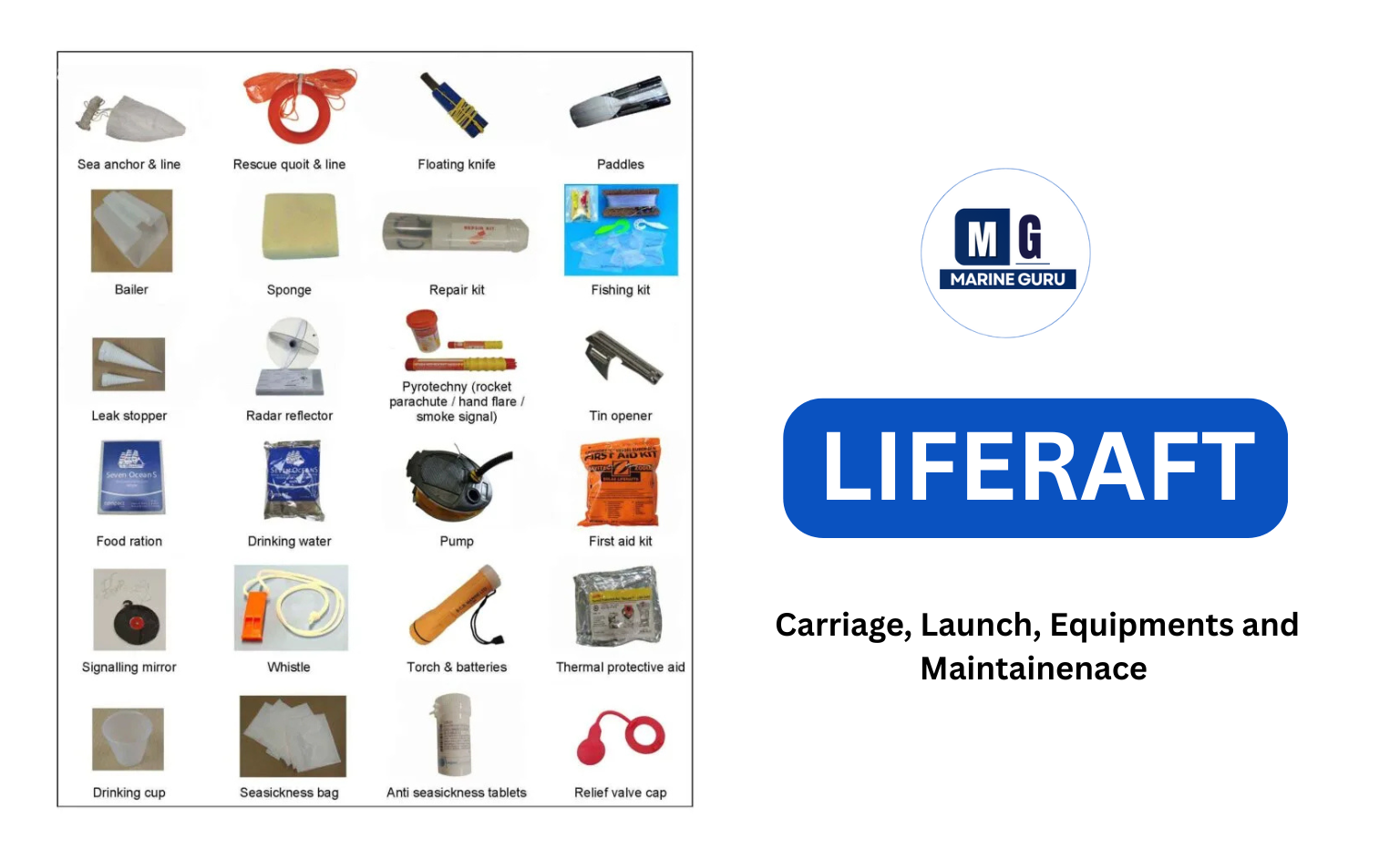
When a ship faces an emergency such as fire, flooding, or sinking, the liferaft becomes the crew’s ultimate lifesaving equipment. Every seafarer must understand how it operates—especially the Hydrostatic Release Unit (HRU), which automatically deploys the liferaft if the ship goes underwater.
This article explains the working principle, components, and operation of a liferaft and HRU in simple, practical terms.
Snippet
A liferaft is an inflatable survival craft designed to keep people safe at sea during emergencies. The Hydrostatic Release Unit (HRU) automatically releases the liferaft when submerged 2–4 meters underwater by sensing water pressure. It cuts the securing strap, allowing the raft to float to the surface and inflate automatically.
How a Liferaft Works on a Ship
A liferaft is stored in a fiberglass canister or valise pack mounted on the ship’s deck. It remains tightly packed until an emergency arises. When released—either manually or automatically—the liferaft inflates using compressed gas (usually CO₂) within seconds.
Main Components
| Component | Function |
|---|---|
| Liferaft Canister | Stores the packed inflatable raft |
| Painter Line | Connects raft to ship; triggers inflation |
| CO₂ Cylinder | Contains gas for inflation |
| Hydrostatic Release Unit (HRU) | Automatically releases raft under water pressure |
| Weak Link | Breaks to free raft after inflation |
| Sea Anchor | Prevents drift in rough seas |
| Survival Equipment Pack | Contains food, water, flares, torch, and first aid items etc, we will look at it later in this article |
Automatic Operation (via HRU)
The Hydrostatic Release Unit (HRU) is a small but crucial device attached between the liferaft and the ship’s cradle.
Step-by-Step Process:
- Submersion: When a vessel sinks, the HRU senses hydrostatic pressure (typically 2–4 meters below water).
- Activation: The HRU blade cuts the strap or rope securing the liferaft canister.
- Floating Free: The raft floats to the surface, still connected via the painter line.
- Inflation Trigger: As the ship continues to sink, tension on the painter line pulls the inflation pin, releasing CO₂ gas.
- Inflation: The liferaft inflates automatically, ready for survivors to board.
- Weak Link Breaks: Once inflated, the weak link snaps to prevent the raft from being dragged underwater.
Manual Operation of a Liferaft
If there is time during an emergency, crew members can release the raft manually:
- Remove the lashings and release from the cradle.
- Carry or throw the canister overboard on the leeward side.
- Pull the painter line sharply (~10 meters).
- The CO₂ gas inflates the raft automatically.
- Survivors board and cut the painter line after boarding to move clear of the ship.
HRU: Types and Maintenance
Types:
- Automatic (Hydrostatic) – Activates underwater pressure.
- Manual Release – Crew activates during emergency.
SOLAS Requirements:
- HRU must comply with SOLAS Chapter III and IMO Resolution A.689(17).
- Each HRU should have:
- Serial number
- Expiry date (usually 2 years from manufacture)
- Replacement certificate onboard
Maintenance Tips:
- Inspect HRU during monthly safety rounds.
- Replace before expiry date.
- Never paint or grease HRU units.
- Verify correct installation direction (“THIS SIDE UP”).
Liferaft Safety and Training Tips
- Conduct liferaft launching drills as per SOLAS schedule.
- Always check painter line condition and CO₂ cylinder pressure.
- Know the capacity and location of your assigned liferaft.
- Replace HRU after every activation or expiry.
What is the full form of HRU in liferaft?
HRU stands for Hydrostatic Release Unit, which automatically deploys a liferaft when submerged underwater.
At what depth does the HRU activate?
Typically between 2 to 4 meters below the water surface.
How often should HRUs be replaced?
Hydrostatic Release Units must be replaced or serviced in line with SOLAS and manufacturer approvals: disposable HRUs are typically replaced every 2 years (some approved models up to 3–4 years), while serviceable (non-disposable) HRUs require periodic servicing, usually annually, with replacement as per maker’s life limits
Can a liferaft be used manually?
Yes, it can be manually launched if there’s enough time during an emergency.
Liferaft Equipment Explained (SOLAS A & SOLAS B Packs): Easy Guide for Seafarers
A liferaft is one of the most vital life-saving appliances on board a ship.
During emergencies like fire or sinking, it provides temporary refuge for the crew until rescue arrives.
But survival at sea depends not only on the liferaft itself — it depends on what’s inside it.
To ensure every raft is properly equipped, SOLAS (Safety of Life at Sea) defines two equipment packs:
SOLAS A and SOLAS B.
These packs differ based on the voyage type:
- Pack A: For long international voyages (ocean-going ships)
- Pack B: For short or domestic voyages (coastal or nearshore ships)
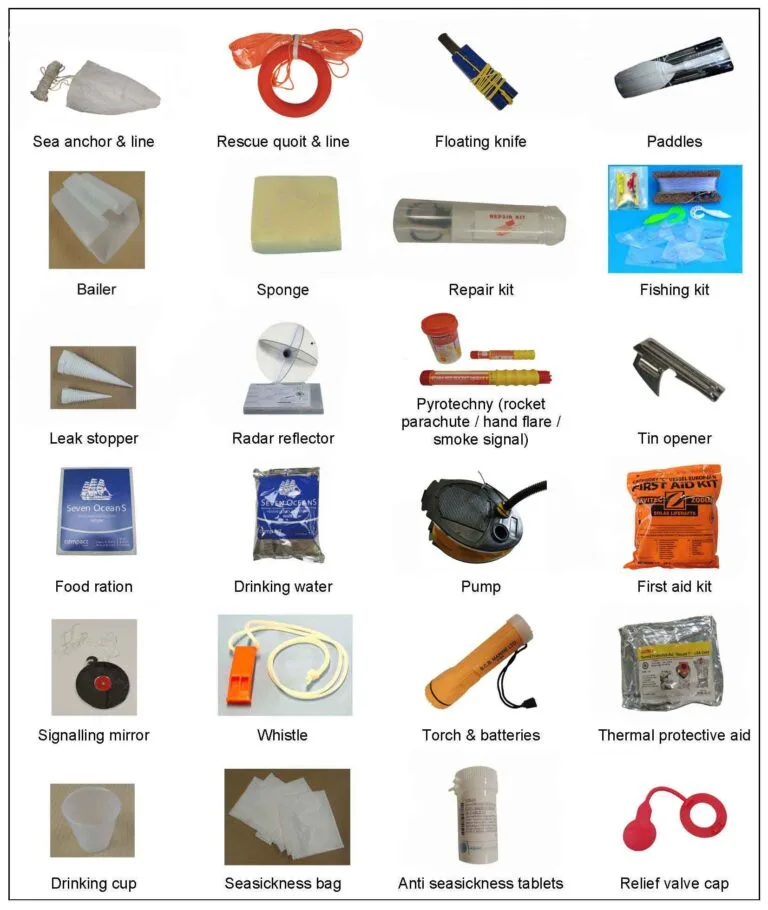
SOLAS A Pack (For Ocean-Going Voyages)
The SOLAS A pack is the most comprehensive because ships on long voyages may wait longer for rescue — sometimes several days.
It’s marked on the raft as “SOLAS A PACK.”
Raft Equipment (for operation & seaworthiness)
| Equipment | Function |
|---|---|
| Buoyant Rescue Quoit (30m line, 1 kN strength) | For man-overboard recovery |
| Safety Knife (1 for <12 persons, 2 for >12 persons) | For cutting painter or lines |
| Buoyant Bailer (1 for <12 persons, 2 for >12 persons) | Removes water from raft |
| Sponges (2) | Wipe out seawater and moisture |
| Sea Anchors (2 total: 1 spare, 1 deployed) | Keeps raft stable in rough seas |
| Buoyant Paddles (2) | Used for maneuvering |
| Tin Openers (3) & Scissors (1 pair) | For opening food rations |
Personal Survival Equipment
| Equipment | Purpose |
|---|---|
| First Aid Kit | Treat minor injuries |
| Fishing Kit | Supplement food rations |
| Food Rations (10,000 kJ/person) | Sustenance during survival |
| Fresh Water (1.5 L/person in watertight container) | Minimum hydration requirement |
| Rust-Proof Drinking Vessel (Graduated) | For rationing water |
| Anti-Seasickness Medicine (6 doses/person) + Bag | Prevent nausea and dehydration |
| Thermal Protective Aids | Prevent hypothermia |
| Printed Survival Instructions | Basic survival guidance |
| “Immediate Action” Instructions (x3) | Quick emergency reference cards |
Signalling & Communication Equipment
| Equipment | Purpose |
|---|---|
| Whistle / Sound Signal | Attract attention nearby |
| Rocket Parachute Flares (4) | Long-distance distress signals |
| Hand Flares (6) | Close-range visibility at night |
| Buoyant Smoke Signals (2) | Daytime distress signal |
| Waterproof Torch (Morse signaling) + Spare bulb & batteries | Night signaling |
| Radar Reflector | Makes raft visible on radar |
| Heliograph (Signal Mirror) | Reflect sunlight for signaling |
| Rescue Signal Table | Reference guide for distress codes |
SOLAS B Pack (For Coastal or Short Voyages)
The SOLAS B pack is a simplified version — intended for voyages where help can reach within 24 hours.
Marked as “SOLAS B PACK.”
Raft Equipment
| Equipment | Function |
|---|---|
| Buoyant Rescue Quoit (30m line) | Rescue line |
| Safety Knife (1 or 2 depending on size) | Cut painter lines |
| Bailer (1 or 2 depending on size) | Remove water |
| Sponges (2) | Wipe water |
| Sea Anchors (2) | Stabilize raft |
| Paddles (2) | Maneuver raft |
Personal Survival Equipment
| Equipment | Purpose |
|---|---|
| First Aid Kit | Treat injuries |
| Fishing Kit | Catch fish if needed |
| Anti-Seasickness Medicine (6 doses/person) | Prevent motion sickness |
| Survival Instructions | Printed in English |
| “Immediate Action” Instructions (x3) | Emergency guide |
| Thermal Protective Aids | Prevent cold shock |
Signalling & Communication Equipment
| Equipment | Purpose |
|---|---|
| Rocket Parachute Flares (2) | Long-range signal |
| Hand Flares (3) | Close range signal |
| Buoyant Smoke Signal (1) | Daytime signal |
| Whistle / Sound Signal | Close contact alert |
| Waterproof Torch + Spare Bulb & Battery | Light & Morse |
| Radar Reflector | For detection |
| Heliograph (Signal Mirror) | Reflect sunlight to attract attention |
🇺🇸 USCG & Coastal Service Variations
For ships under the United States Coast Guard (USCG) and domestic voyages:
- Similar to SOLAS B, but may include:
- Automatic interior light
- Pressure relief valves
- Rainwater catchments and storage bags
- Jackknife
- Repair kit
- Leak stoppers
- Bailer & pump
- Flashlight with spare bulbs & batteries
How to Remember Liferaft Equipment – The Survival Story Method
Here’s an easy memory story that helps you recall what’s inside the raft — from Raft Kits → Survival Kits → Signaling Tools.
The “Sea Survival Story”
Imagine you’ve just abandoned ship in the middle of the ocean.
You climb into a floating orange tent — that’s your liferaft.
- You cut the painter line with your safety knife, push away with paddles, and drop the sea anchor so you don’t drift too far.
(Raft Kits: knife, paddles, sea anchor, bailer, sponges) - Inside, you find food rations, water bottles, and even a fishing kit — you’re ready to survive.
(Personal Survival Items: food, water, fishing tackle, first aid, thermal aids) - Feeling seasick? You pop an anti-seasickness tablet, then check the printed survival manual that tells you “Don’t panic, conserve energy.”
(Survival Instructions & medicine) - You see a ship far away! You grab your rocket parachute flares, shoot them into the sky, and wave your heliograph mirror toward the sun.
(Signaling Equipment: flares, heliograph, whistle, torch, radar reflector) - At night, you turn on your torchlight, blow the whistle, and hold up a smoke signal when daylight comes.
(More signaling tools) - Finally, you remember — everything you used was part of SOLAS Pack A, the ocean survival pack.
For coastal voyages, you’d just need half of these items — that’s Pack B.
👉 Memory Tip:
Think 3 Survival Zones:
- Raft Zone: Tools to float and steer.
- Life Zone: Food, water, medicine.
- Signal Zone: Tools to get rescued.
That’s how you can recall the entire SOLAS A/B list in 3 steps during an orals exam or onboard drill.
SOLAS Requirements for Carriage and Construction of Liferafts
Under SOLAS Chapter III (Life-Saving Appliances and Arrangements) and the LSA Code, all merchant vessels must comply with the following:
1. Carriage and Placement
- Every cargo and passenger ship must carry SOLAS-compliant liferafts sufficient to accommodate all persons onboard.
- Cargo ships:
- Must carry one or more liferafts on each side of the vessel.
- Must have aggregate capacity for all crew and passengers.
- If any survival craft is more than 100 meters from the bow or stern, an additional “remote liferaft” must be placed in that area.
- Remote liferafts:
- Do not require HRUs, but must have rapid manual release arrangements and proper embarkation access.
- Can be stowed without a launching device, but must allow easy deployment.
2. Construction and Performance Standards
Each liferaft must:
- Survive afloat for at least 30 days in all sea conditions.
- Withstand an 18-meter drop test without damage (or higher if stowed above 18 m).
- Allow safe repeated jumps from 4.5 meters by personnel.
- Be towable at 3 knots when fully loaded.
- Davit-launched rafts must withstand:
- A 3.5 m/s lateral impact, and
- A 3 m vertical drop while loaded.
- Have a minimum capacity of 6 persons.
- If not served by a launching device, the raft’s total weight (including container and equipment) must not exceed 185 kg for manual handling.
3. Canopy and Habitability
- The canopy must deploy automatically upon inflation.
- It must:
- Protect occupants from wind, rain, and sea spray.
- Admit adequate ventilation.
- Have at least one observation port.
- Provide rainwater collection facilities.
- Have non-irritant interior colors and adequate headroom for seated occupants.
- Include a mounting point for SART (Search and Rescue Transponder) at least 1 meter above sea level.
4. Equipment and Identification
- Packed in a watertight, buoyant container able to resist marine wear and corrosion.
- Each liferaft must be clearly marked with:
- Manufacturer and serial number
- Approving authority
- Capacity and SOLAS pack type (A or B)
- Last service date and service station
- Maximum stowage height
- Launching instructions
- Hydrostatic Release System (painter, senhouse slip, HRU, weak link) must be correctly rigged and approved by the flag administration.
5. Launching and Stowage Arrangements
- Liferafts should be stowed for automatic release if the ship sinks.
- Must be equipped with a painter line permanently attached to the ship.
- Davit-launched liferafts must have means to:
- Control lowering.
- Secure the raft at the embarkation deck during boarding.
- Passenger ships must be able to evacuate all persons within minutes as per flag requirements.
- Embarkation arrangements should allow safe boarding without needing knotted lines or climbing ropes.
6. Passenger and Cargo Ship Specifics
- Passenger ships may use a combination of lifeboats and liferafts.
- At least 25% of total survival capacity must be provided by liferafts.
- All such arrangements must meet the flag administration’s approval in accordance with SOLAS Chapter III.
Key SOLAS Numeric Thresholds
| Parameter | Requirement |
|---|---|
| Liferaft survivability | 30 days afloat |
| Drop height test | 18 m (or more if stowed higher) |
| Jump tolerance | 4.5 m |
| Tow speed | 3 knots when fully loaded |
| Impact resistance | 3.5 m/s lateral, 3 m vertical |
| Minimum capacity | 6 persons |
| Manual handling weight | ≤ 185 kg |
| Remote raft placement | Required if >100 m from nearest survival craft |
How does a liferaft inflate automatically?
When the painter line is pulled, it triggers the CO₂ gas cylinder, inflating the raft within seconds.
In case of sinking, the Hydrostatic Release Unit (HRU) automatically activates to release and inflate the raft.
What is the function of the HRU in a liferaft?
The Hydrostatic Release Unit (HRU) releases the liferaft automatically when submerged 2–4 meters underwater.
It cuts the securing strap, allowing the raft to float free and inflate even if no one is onboard to launch it.
What are SOLAS requirements for carrying liferafts?
Ships must carry SOLAS-approved liferafts for all persons onboard.
Cargo ships need liferafts on both sides of the vessel.
If a survival craft is more than 100 meters from the bow or stern, additional remote liferafts must be fitted.
Each raft must have a minimum capacity of 6 persons and be launchable manually or automatically.
What are the construction requirements for a SOLAS liferaft?
Must survive 30 days afloat in all sea conditions.
Withstand an 18-meter drop without damage.
Support repeated 4.5-meter jumps by personnel.
Be towable at 3 knots when loaded.
Davit-launched types must resist 3.5 m/s lateral impact and 3 m vertical drop.
How is a liferaft launched manually?
Remove lashings and release from the cradle.
Throw the canister overboard on the leeward side.
Pull the painter line (≈10 m) to trigger inflation.
Board the raft and cut the painter line after boarding.
What markings must be on a SOLAS liferaft?
Each raft must show:
Manufacturer and serial number
Approval authority
Capacity and SOLAS pack type
Date of last service
Max stowage height
Launching instructions
How often must liferafts and HRUs be serviced?
Liferafts: Annually at an approved service station.
HRUs: Every 2 years or as per the manufacturer’s certificate.
Other Important Links inside Marienguru:


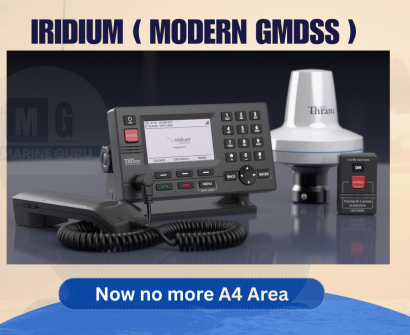
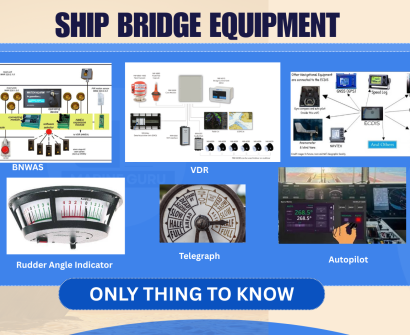
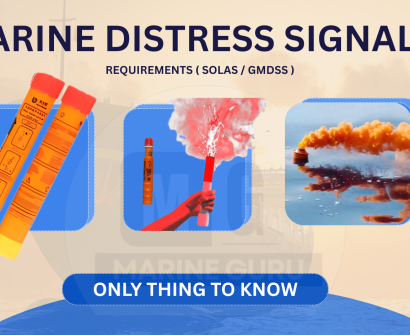
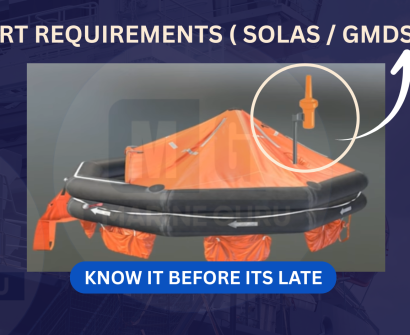
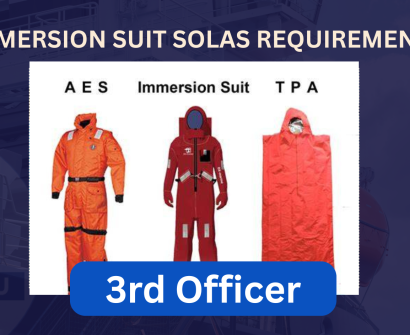
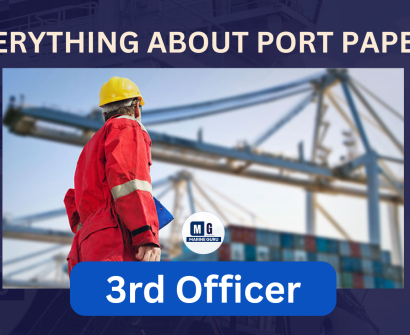

What You Don't Know About Lifebuoys Requirements In 2025
[…] How Liferaft and Hydrostatic Release Unit (HRU) Work – Complete All in 1 Guide […]